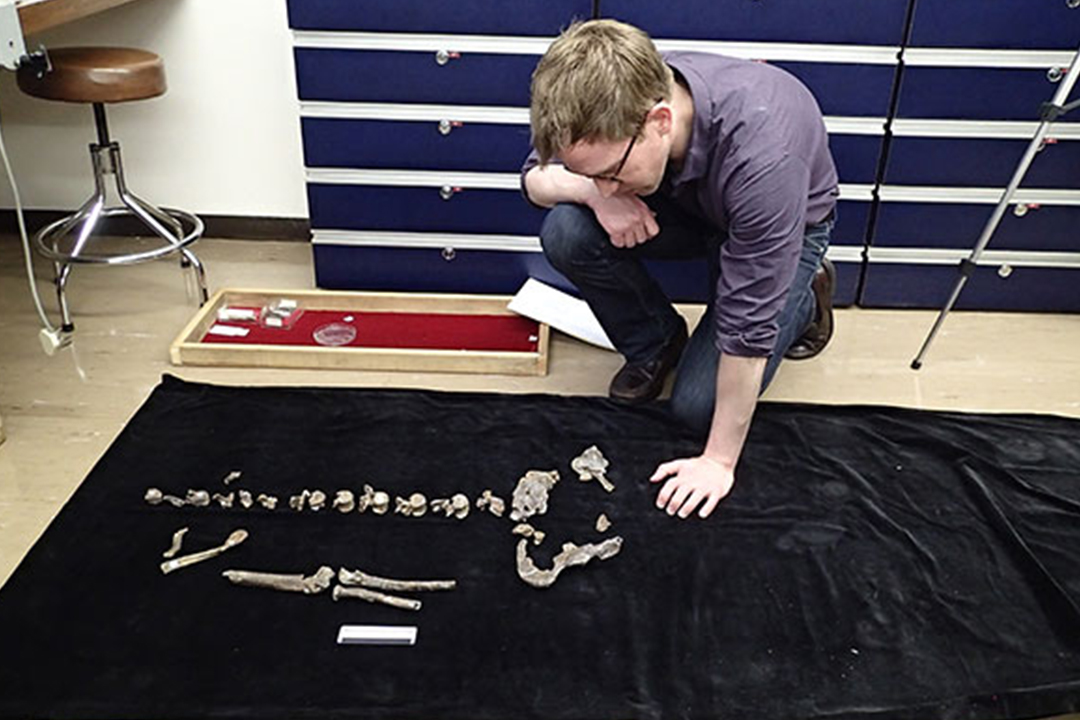Nearly 3 million years ago, the earliest members of the Homo genus—which includes our species Homo sapiens, or modern humans—emerged as the bully on the evolutionary block. They distinguished themselves from other hominin species with their frequent tool use and larger braincase. And, the scientific community has widely concurred, our early ancestors were just bigger. Their larger body mass set them apart and helped kick start the origin of humans.
But a new study co-authored by Mark Grabowski, assistant research professor in the Center for the Advanced Study of Human Paleobiology, rocked the evolutionary studies world and cut the Homo genus down to size. Using state-of-the-art methodology and the largest sample of early hominin fossils ever assembled, Grabowski produced the first large new set of body mass estimates in more than 20 years. The study revealed that early human ancestors were smaller than previously believed—in fact, they were no larger than their hominin counterparts. As a result, a body mass boost could not have been the catalyst for modern human evolution.
“Our results found no evidence that the earliest members of our genus differed in body mass from earlier australopiths, some of the earliest species of hominins,” said Grabowski, a biological anthropologist and evolutionary biologist. “In other words, the factors that set our lineage apart from our earlier ancestors were unrelated to an increase in body size, which has been the linchpin of numerous adaptive hypotheses on the origins of our genus.”
Long-accepted theories have surmised that a body-size increase—coinciding perhaps with an increase in meat consumption—significantly widened the evolutionary gap between Homo genus and the large-toothed, solid-jawed australopiths. In the study, which was published in The Journal of Human Evolution, Grabowski and his co-authors debunk the notion that early members of the Homo genus had a body mass that approached modern human levels. “Early Homo had a slightly larger brain than earlier species, but was similarly small bodied,” he said. Instead, evidence of body-size increase doesn’t occur in the known fossils until later in Homo erectus, the first species widely found outside of Africa.
Numerous theories regarding the origins of Homo hinge on the purported body-size jump at specific times in the evolutionary chain. Until now, anthropologists’ calculations have relied on estimates presented in a 1992 paper by Henry M. McHenry, a renowned professor of anthropology at the University of California, Davis. Grabowski didn’t set out to correct the prior work; rather, he wanted to update McHenry’s research. Since the McHenry study—the last major review of hominin body size—“new fossils have been discovered, species attributions have been clarified and methods improved,” Grabowski said.
In 1992, McHenry himself cautioned that his findings were merely an “important first step” and not a definitive analysis. But over time, the McHenry figures have become the standard touchstone for fossil hominin body estimate. “Despite McHenry’s caveats about uncertainty regarding some of the estimates,” Grabowski said, “the results of this study have often been used with more confidence than might be warranted.” Grabowski and his fellow researchers describe their findings as the most comprehensive set of body mass estimates, species averages and species averages by sex for fossil hominins to date.
Monogamy vs. ‘Harems’
While body size may not have started our ancestors on the road to becoming us, it still plays a key role in evolutionary science and is vital for understanding early species’ place in the natural world, Grabowski noted.
Body size is linked to a host of species-development factors such as energy requirements, home range size, relative brain size, locomotion, diet, life history and behavior. “Our results in no way suggest there was no connection [between body size and evolution],” Grabowski said. But inaccurate body size estimates also distort our understanding of a species’ relationship to its epoch and its environment. “For example, home range size [the area occupied during the life of an animal or human] is related to body size,” Grabowski explained. “If [the species’] body size was smaller than our previous estimates then our home range sizes are also off.”
Beyond the body mass bombshell, Grabowski also uncovered important hints to early human’s social structures. The study revealed that the size difference between males and females, known as sexual dimorphism, decreased to modern human-like levels later in our lineage than believed. Low levels of dimorphism suggest a monogamous social structure, while high levels correlate with more “harem”-like social structures as seen, for example, in gorillas.
“Levels of dimorphism seem to reflect how groups are organized, whether there is an alpha male and lots of females, or a one-male-one-female structure,” Grabowski said. “Some people thought that while the earliest fossils were very dimorphic, like gorillas, early Homo had levels similar to modern humans.” But the findings challenge evolutionary assumptions that the early Homo genus lived in monogamous circles.


